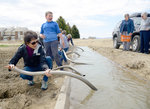Clear, 75° F
It was 150 years ago, on May 24, that John Wesley Powell set off with 10 other men, down the Green River, through Utah, and then down the Colorado River through the Grand Canyon.
Besides …
This item is available in full to subscribers.
The Powell Tribune has expanded its online content. To continue reading, you will need to either log in to your subscriber account, or purchase a subscription.
If you are a current print subscriber, you can set up a free web account by clicking here.
If you already have a web account, but need to reset it, you can do so by clicking here.
If you would like to purchase a subscription click here.
Please log in to continue |
|



It was 150 years ago, on May 24, that John Wesley Powell set off with 10 other men, down the Green River, through Utah, and then down the Colorado River through the Grand Canyon.
Besides exploring largely unknown territory, Powell recognized that the arid climate of the West would require a different way of thinking about water.
“Because of this man’s work is why [the City of] Powell exists,” said Rebekah Burns, Powell Visitor Center coordinator.
To the best of anyone’s knowledge, John Wesley Powell never actually set foot in this area, but he was a large influence on water reclamation, which has been vital to survival in the Big Horn Basin. Without irrigation, crops could never grow here.
The visitor center, which operates under the umbrella of Powell Economic Partnership (PEP), is holding a series of events this month in honor of the city’s namesake. On May 7, PEP hosted a talk by Bighorn Canyon National Recreation Area Park Ranger Todd Johnson at the Homesteader Museum. Johnson spoke on Powell’s historic journey down the Colorado River and his advocacy of water management.
Powell made his journey, Johnson explained, at a time the nation was moving out West — a migration facilitated by the newly completed transnational railroad.
After a second expedition down the Colorado, Powell moved to Washington, D.C., where he eventually became the second director of the U.S. Geological Survey. In that position, he continued to advocate for policies that would facilitate irrigation practices, allowing homesteads to become successful farming operations in the area’s bone-dry climate. He argued that water rights should go with the land and not the person.
“He was the voice of reason,” Burns said at Monday’s City Council meeting, where the council approved a proclamation making Friday, May 24, John Wesley Powell Day.
While Powell’s advice guides reclamation today, his work wasn’t well-received in his time.
“A lot of people weren’t on board with his vision,” Johnson explained.
After political opposition kept his proposals at bay, Powell resigned his position with the USGS.
Only after his death in 1902 did Washington bureaucrats realize the foresight of his policy proposals and start to implement water management projects. These projects include the canals and dams found throughout the Basin that irrigate its agricultural industry.
On May 11, PEP coordinated an agricultural tour around the area, with a focus on water management.
Local farmer Beryl Churchill led the group and discussed what life was like for the early homesteaders; they somehow made a living out of farms in this climate, most of them without any irrigation.
Standing near the Corbett Dam, Churchill explained that the sagebrush surrounding the dam is what homesteads looked like when their owners first arrived. Using early 20th century equipment, these hardy folks had to clear away the native vegetation and plow their fields.
She said some 90 percent had no irrigation initially, and there was no clear plan for all the dams and canals that allow farms to be adequately irrigated today.
“They didn’t know how to handle water,” she said.
Despite the hardships, Churchill said about 80 percent of the original homesteaders stayed and raised their families here.
Things did get quite a bit easier as infrastructure projects brought water from the rivers to the farms.
Built in 1908, the Corbett Dam diverts water from the Shoshone River into a 3 1/2-mile tunnel that was dug largely with picks and shovels. It connects to the Garland Canal, which eventually runs along Coulter Avenue through the heart of Powell. From there, small canals called laterals transport the water to farms, including Churchill’s.
Farmers have to purchase their water, and the rates vary depending on the division the farm is located. In the Garland Division, it’s about $26 per acre-foot.
Ditch riders manage access to water in the canals and laterals. Farmers try to maintain a good relationship with them, Churchill said, as the ditch riders have the authority to close your water gates and effectively kill your entire farming operation.
Of course, farmers understand just how valuable the water is, and so Churchill said it’s quite rare any producers in the area break the rules.
During the tour, she demonstrated how siphoning tubes are used to pull water from the laterals onto the plowed fields. After decades of experience, it was a quick, fluid motion for her to get the water flowing steadily through the tube onto the field. The tour participants struggled to get more than a dribble from the pipe.
Churchill and her husband have long retired, but they still continue to farm.
“It’s an awful nice way to make a living,” she said.
Powell library hosts presentation on John Wesley Powell
The Powell Branch Library will host an evening program on Thursday, June 6, in honor of the 150th anniversary of the Powell Expedition. Rebekah Burns, Powell Visitor Center Coordinator, will speak about the expedition at 7 p.m. The program is free and open to all ages. Light refreshments will be served. For additional information, contact the Powell Branch Library at 754-8828 or visit www.parkcountylibrary.org.